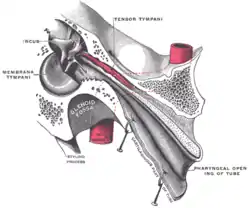Torus tubarius
The base of the cartilaginous portion of the Eustachian tube (auditory tube), lies directly under the mucous membrane of the nasal part of the pharynx, where it forms an elevation, the torus tubarius, the torus of the auditory tube, or cushion, behind the pharyngeal orifice of the tube. The torus tubarius is very close to the tubal tonsil,[1] which is sometimes also called the tonsil of (the) torus tubarius.[2]
| Torus tubarius | |
|---|---|
 Auditory tube, laid open by a cut in its long axis (torus tubarius not labeled) | |
| Details | |
| Identifiers | |
| Latin | Torus tubarius |
| TA98 | A05.3.01.012 |
| TA2 | 2868 |
| FMA | 54993 |
| Anatomical terminology | |
Two folds run posteriorly and anteriorly:
- posteriorly, the vertical fold of mucous membrane, the salpingopharyngeal fold, stretches from the lower part of the torus tubarius; it contains the Salpingopharyngeus muscle which originates from the superior border of the medial lamina of the cartilage of the auditory tube,[3] and passes downward and blends with the posterior fasciculus of the palatopharyngeus muscle.
- anteriorly, the second and smaller fold, the salpingopalatine fold, smaller than the salpingopharyngeal fold, contains some fibers of muscle, called salpingopalatine muscle by Simkins (1943),[3] it stretches from the superior border of lateral lamina of the cartilage, anteroinferiorly, to the back of the hard palate. The tensor veli palatini does not contribute to the fold, since the origin is deep to the cartilaginous opening.
See also
References
This article incorporates text in the public domain from page 1043 of the 20th edition of Gray's Anatomy (1918)
External links
- Anatomy photo:31:14-0102 at the SUNY Downstate Medical Center
- MedEd at Loyola grossanatomy/dissector/labs/h_n/nasal/na4_1.html
- "Anatomy diagram: 25420.000-1". Roche Lexicon - illustrated navigator. Elsevier. Archived from the original on 2015-02-26.
This article is issued from Wikipedia. The text is licensed under Creative Commons - Attribution - Sharealike. Additional terms may apply for the media files.